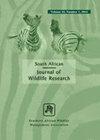The Influence of Population Demographics on Lion (Panthera leo) Growth Rates in Small, Fenced Wildlife Reserves
引用次数: 2
Abstract
Rapid population growth of reintroduced lions (Panthera leo) poses several ecological and management challenges in small (<1000 km2), fenced wildlife reserves. Changes in the natural social-ecological conditions of reintroduced lions can lead to a breakdown of natural predator–prey relationships and this is undesirable from both a biodiversity conservation and wildlife management perspective. Here, we present lion population vital rates across 16 small, fenced reserves in South Africa to test whether varying social ecological conditions, associated with lion population structures, can drive changes in vital rates. Study reserves were categorized (A–D) according to the number of resident prides and male coalitions. Lion population structure within a reserve affected lion vital rates differentially, and lion population growth was highest in reserves that contained a single resident pride. The presence of more than one pride in a reserve resulted in a younger age at first birth and marginally longer birth intervals. The presence of extra-pride adult males reduced cub survival, lioness age at first birth and birth intervals. These results can inform lion management decisions and, in particular, how lion population structure affects management outcomes. Our results also inform appropriate management protocols for lions depending on the specific social and ecological context of an individual reserve.人口统计对小型围栏野生动物保护区狮子(Panthera leo)生长速度的影响
在面积小于1000平方公里的小型围栏野生动物保护区,重新引入的狮子(Panthera leo)种群的快速增长带来了一些生态和管理挑战。重新引入狮子的自然社会生态条件的变化可能导致自然捕食者-猎物关系的破裂,从生物多样性保护和野生动物管理的角度来看,这是不可取的。在这里,我们展示了南非16个小型围栏保护区的狮子种群生命率,以测试与狮子种群结构相关的不同社会生态条件是否会导致生命率的变化。研究储备根据居民自豪感和男性联盟的数量进行了分类(A-D)。保护区内的狮子种群结构对狮子的存活率有不同的影响,而只有一个居民自豪感的保护区的狮子种群增长率最高。一个保护区中存在不止一种自豪感,导致第一次出生时年龄较小,出生间隔稍长。成年雄性狮子的出现降低了幼崽的存活率、母狮第一次出生时的年龄和出生间隔。这些结果可以为狮子管理决策提供信息,特别是狮子种群结构如何影响管理结果。我们的研究结果还为狮子提供了适当的管理方案,具体取决于单个保护区的特定社会和生态环境。
本文章由计算机程序翻译,如有差异,请以英文原文为准。
求助全文
约1分钟内获得全文
求助全文

 求助内容:
求助内容: 应助结果提醒方式:
应助结果提醒方式:


